Date published: 5 March 2021
The Chubu region, which consists of nine prefectures (including Gifu, Nagano, and Ishikawa), is located in the middle of Japan and is popular among foreign visitors. Its appeal lies in its richness of tradition and history, like the World Heritage Site of Shirakawa-go and the National Treasure, Matsumoto Castle.
Besides, there are many exciting places, like Shinhodaka, where you can enjoy the beautiful autumn leaves, or Okuhida Onsengo, with its hot springs, and Hida Takayama and its popular old-Japanese-style landscapes.
Driving around would be a convenient way to see all these attractions. Still, many people are worried about driving in a foreign country. That’s why today we’d like to introduce you to a 3-day and 2-night bus travel route from Tokyo via public busses. This will allow you to see the sights easily and efficiently with little need for reservations.
Refer to this guide for information on busses and fares.
-
1
Day 1 (7AM): Depart from Busta Shinjuku, Japan’s largest express bus terminal
-
2
10:30AM: Arrive at Matsumoto around; visit the National Treasure Matsumoto Castle and taste shinshu soba
-
3
3:30PM: Arrive at Hirayu Onsen – be healed by waterfalls and autumn leaves
-
4
6PM: Check-in at Miyama Ouan Ryokan
-
5
Day 2 (Depart at 8:30AM): Enjoy the spectacular view of the Northern Alps from the bus window
-
6
9:20AM: Arrive and take the Shinhotaka Ropeway
-
7
1:30PM: Arrive and take a stroll along Sanmachi Street, a must-see for Hida Takayama visitors!
-
8
5PM: Check in at Takayama Green Hotel – enjoy the Japanese garden and Hida beef dinner!
-
9
Day 3: Visit Shirakawa-go to experience the original landscape of Japan
-
10
9:30AM: Arrive and enjoy the World Heritage site of Shirakawa-go!
-
11
1:35 PM: Finishing in Kanazawa, home to one of Japan’s most famous gardens and rich samurai culture
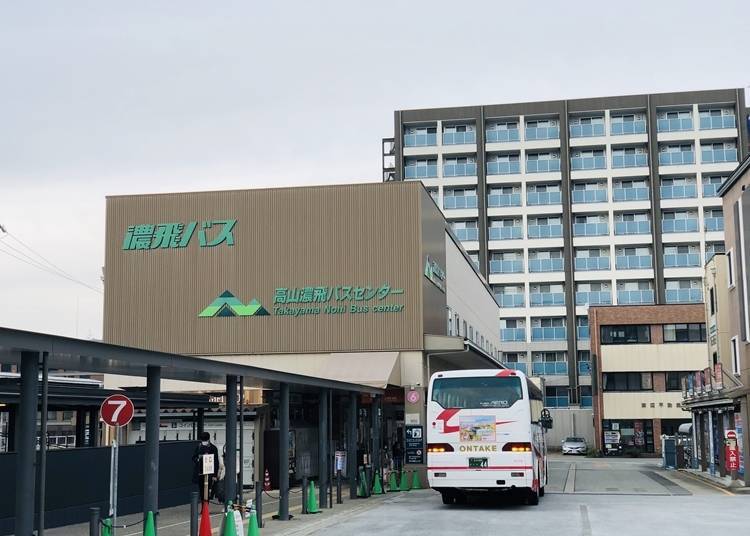
Takayama Nohi Bus Center
1
Day 1 (7AM): Depart from Busta Shinjuku, Japan’s largest express bus terminal
Our journey begins at Busta Shinjuku (Shinjuku Bus Terminal), the largest express bus terminal in Japan, located on Tokyo’s west side. On the first day, we will travel through Matsumoto city in Nagano Prefecture to Hirayu Onsen, one of the Okuhida Onsen Villages around Takayama City, Gifu Prefecture.
Busta Shinjuku directly connects Tokyo with 300 cities in 39 prefectures throughout Japan. From here, you can board an express bus bound for Matsumoto Bus Terminal in Matsumoto City, Nagano Prefecture. The fare is 3,800 yen (one way) if purchased at the counter, or 3,500 yen (one way) if booked and purchased online.
For more information on how to get to Busta Shinjuku and how to buy tickets on the day, please see the article below.
-

-
Address
Busta Shinjuku, 5-24-55 Sendagaya, Shibuya-ku, Tokyo, 151-0051
View Map
-
Nearest Station
Shinjuku Station (JR Shonan Shinjuku Line / JR Yamanote Line / JR Chuo Main Line / JR Saikyo Line / Tokyo Metro Marunouchi Line / Toei Shinjuku Line / Toei Oedo Line / Keio Line / Keio New Line / Odakyu Odawara Line)
2 minutes on foot
-
Phone Number
00-0000-0000
-
Address
2
10:30AM: Arrive at Matsumoto around; visit the National Treasure Matsumoto Castle and taste shinshu soba
After a three-hour bus ride, we get off at the Matsumoto Bus Terminal. Our destination is Matsumoto Castle, designated a national treasure of Japan.
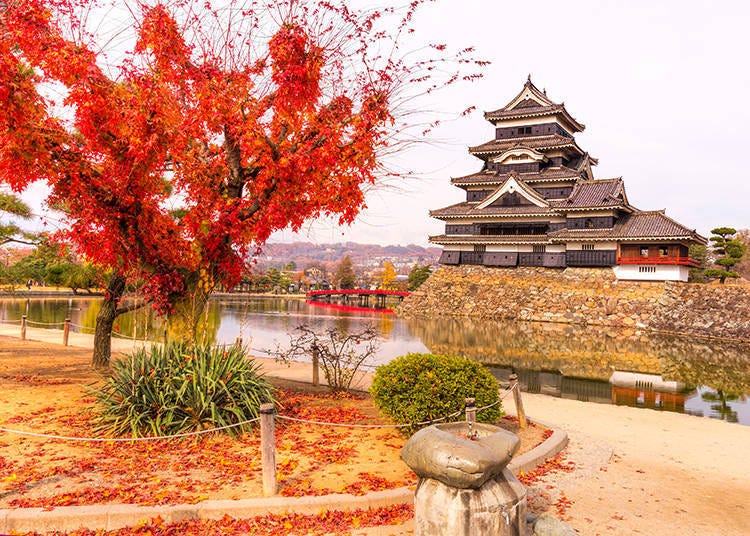
There are only 12 castles in Japan that still have their castle towers. Of the five-story castle towers, Matsumoto Castle is the oldest in Japan, built 400 years ago. Not only will you be able to see this spectacular castle from up close, but you will also be able to enter it, which will surely be very satisfying.
-
Matsumoto Castle
松本城
-
Address
4-1 Marunouchi, Matsumoto, Nagano, 390-0873 Japan -
Phone Number
0263-32-2902
Open: 8:30 AM -5 PM; Golden Week and summer period: 8 AM – 6 PM (last admission 30 minutes before closing)
Admission: Adults 700 yen and junior high school students 300 yen
Closed: December 29 – 31 (hours may change on January 1 – 3 – please check the official website for details) -
Address
After a leisurely tour of the castle, take a stroll through the charming castle town. We recommend trying Soba Club Sasaki, a restaurant near Matsumoto Castle that serves shinshu soba at lunchtime.
Soba has long been made in Nagano Prefecture, which with its high altitude and cool climate, makes for an excellent environment for soba.
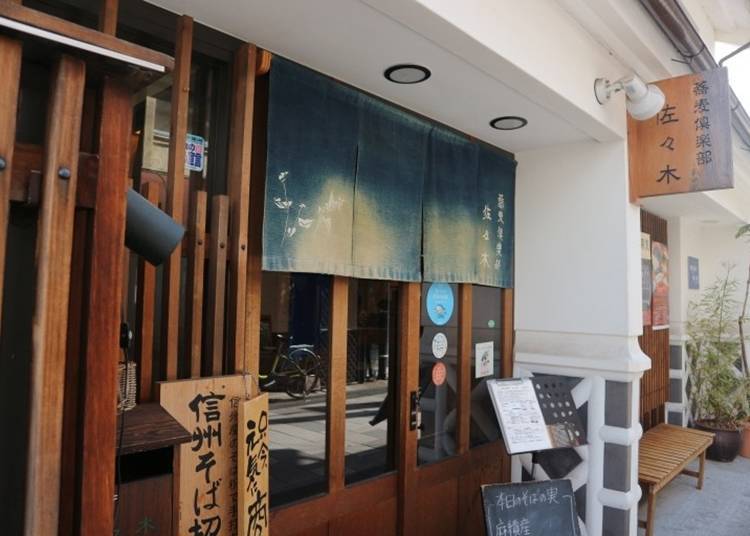
When we visited, we had a simple morisoba. We tossed the fragrant shinshu soba noodles in the dipping sauce made from natural broth and savored its rich flavor. Also excellent are the soba gaki, made by dissolving buckwheat flour in water and then kneading it over the fire, and yaki miso, made by adding several ingredients to miso and roasting it. You can also enjoy local sake and craft beer.
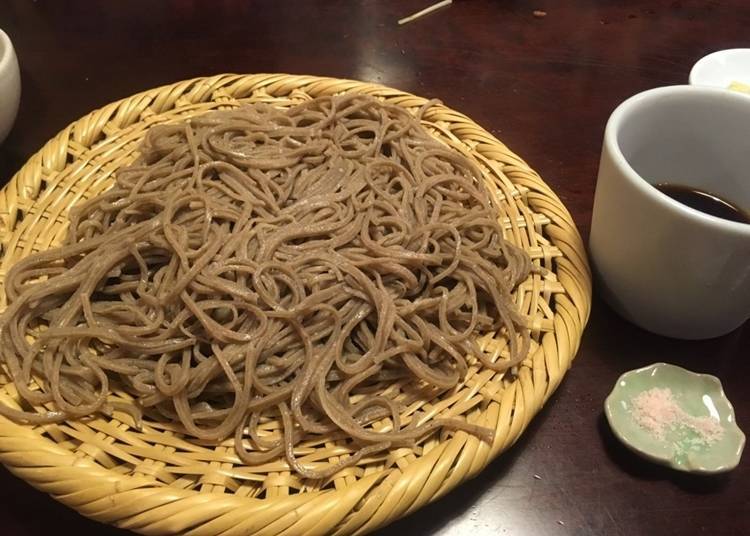
Morisoba, 1,000 yen (tax included). There are also kakesoba (buckwheat noodles with hot sauce) and tsukimi soba (with onsen egg topping).
-
Soba Noodle Club Sasaki
蕎麦倶楽部 佐々木
-
Address
4-8-3, Ote, Matsumoto, Nagano, 390-0874 -
Phone Number
0263-88-3388
Open: 11:30 AM – 2:30 PM, 6 PM – 8 PM (closed when sold out)
Closed: Monday, Sunday night (if Monday is a national holiday, the shop will close on Tuesday instead) -
Address
At around 2 PM, we boarded the Nohi Bus again from the Matsumoto Bus Terminal and departed for our next destination, Hirayu Onsen in Okuhida Onsen Village in Takayama City, Gifu Prefecture.
Tickets can be purchased at the Matsumoto Bus Terminal and cost 2,700 yen for a one-way trip to Hirayu Onsen.

-
Matsumoto Bus Terminal
松本バスターミナル
-
Address
1-2-30, Fukashi, Matsumoto, Nagano 390-0815 -
Nearest Station
JR Matsumoto Station
Open hours: 6 AM – 7 PM
-
Address
3
3:30PM: Arrive at Hirayu Onsen – be healed by waterfalls and autumn leaves
After about an hour and a half of riding the bus along the mountain road, we arrived at the Hirayu Bus Terminal.
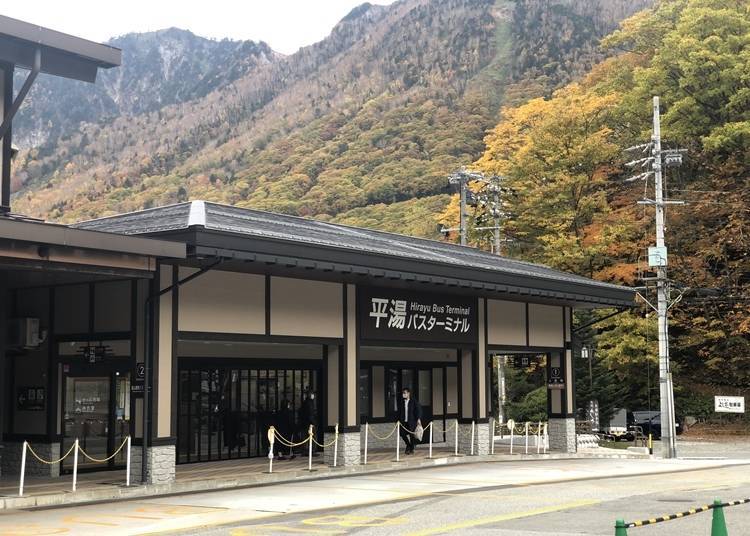
It was a long bus ride, so we went to see the autumn leaves at Hirayu Great Falls, to stretch our legs as well. It takes about 15 minutes to get there on foot from Hirayu Bus Terminal.
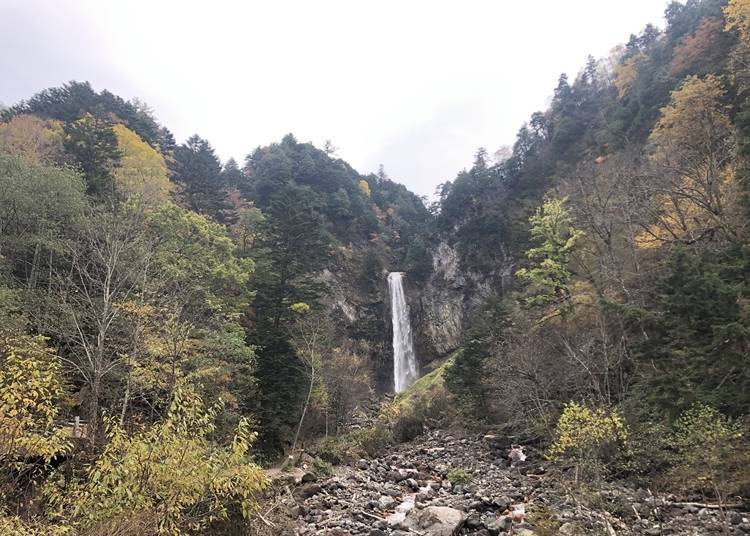
The best time to see the autumn leaves is from early October to early November every year. Hirayu Great Falls, with a drop of 64 meters and a width of 6 meters, is one of the Three Great Waterfalls of Hida, and has been selected as one of the top 100 waterfalls in Japan.
It was a little early in the season for the colorful autumn leaves, but I was soothed by the beautiful contrast of the leaves and the powerful waterfall.
-
Hirayu Great Falls
平湯大滝
-
Address
Address: Okuhida Onsengo Hirayu, Takayama, Gifu, 506-1433
Phone: 0578-89-2614 (Okuhida Onsen Resort Tourism Association)
Free access -
Address
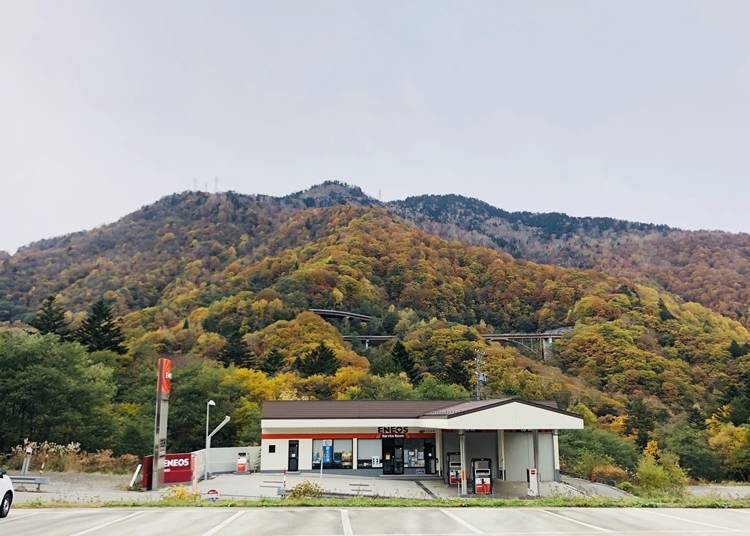
All the scenery you can see while strolling around is colorful and very pleasant.
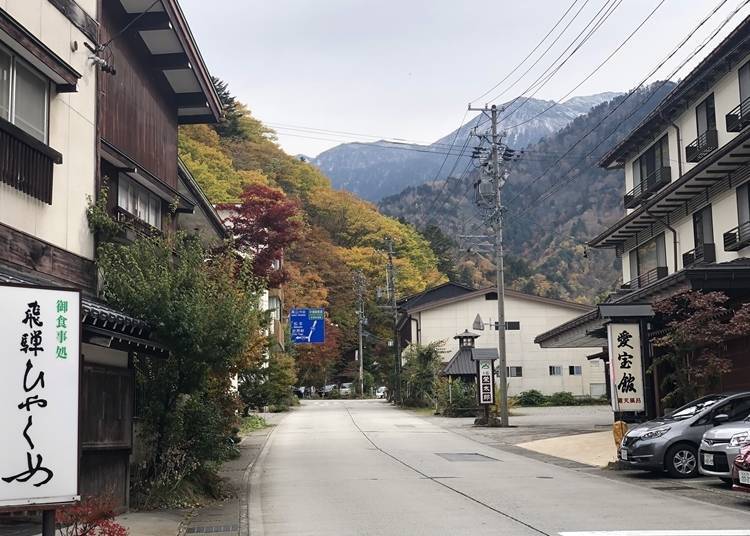
The hot spring town of Hirayu Onsen is also very charming, and you can enjoy it even by just walking around.
4
6PM: Check-in at Miyama Ouan Ryokan
We stayed at the famous ryokan inn, Miyama Ouan, in Hirayu Onsen, characterized by its bold wooden building. The inn was built by a Hida master whose saying was “I walk with trees, I grow up with trees, and trees are my life,” as a “building that should be preserved for future generations.”

The stately entrance gate with its beautiful autumn leaves (image courtesy of: Kyoritsu Maintenance)
Most of the guest rooms are Japanese-Western style, and you can feel the warmth of the calming wood.
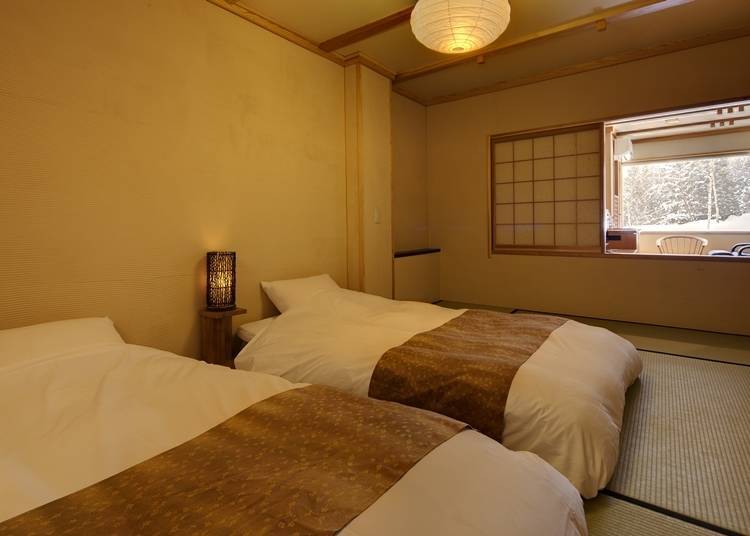
There is also an open-air bath where you can enjoy the view of autumn leaves (image courtesy of Kyoritsu Maintenance)
Enjoy three different hot springs, and relax your body and mind. There is also a foot bath at the entrance (closed in winter).
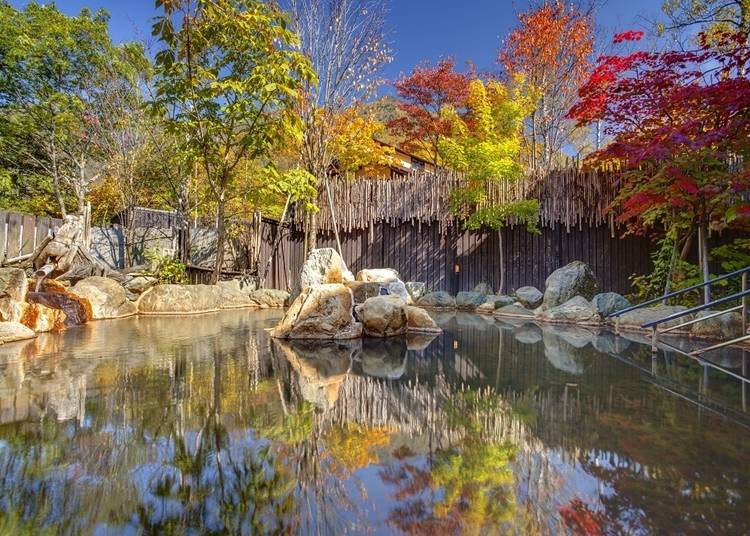
An outdoor bath with a view of autumn leaves (image courtesy of Kyoritsu Maintenance)
Japanese kaiseki meals are served at a sunken hearth table in the dining room. The main course is Hida beef, a Japanese beef brand raised in the Hida region of Gifu Prefecture. The fine texture and beautiful marbling of the meat will melt in your mouth.
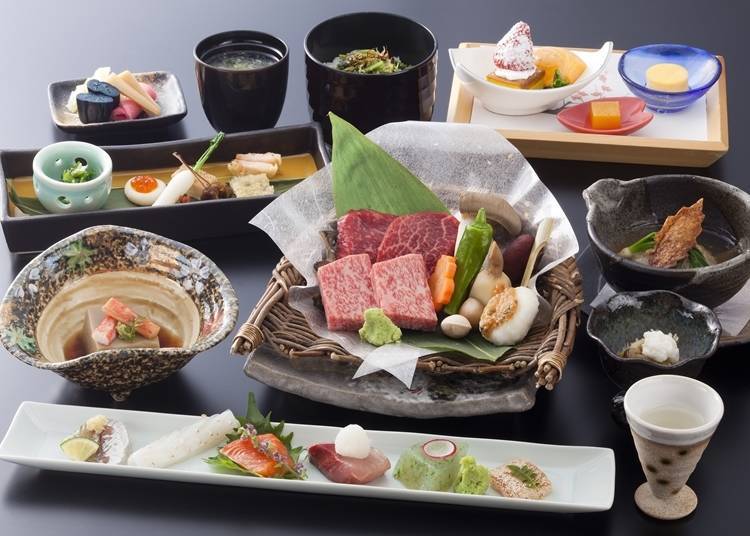
Example of a Japanese Kaiseki (Image courtesy of Kyoritsu Maintenance)
Tuck into a delicious meal and warm yourself up to the core in a natural hot spring. This is the true pleasure of a Japanese onsen ryokan. I slowly drifted off to sleep, surrounded by the warmth of the wood.
-
Miyama Ouan
匠の宿 深山桜庵
-
Address
229 Okuhida Onsengo Hirayu, Takayama, Gifu 506-1433 -
Phone Number
0578-89-2799
Check-in: 3 PM
Check-out: 11 AM
Rates: From 25,000 yen per person per room for two people in a Japanese-Western room (with two meals per night. Bath tax not included) -
Address
5
Day 2 (Depart at 8:30AM): Enjoy the spectacular view of the Northern Alps from the bus window
On the second day, we planned to enjoy the magnificent nature of the Northern Alps and Hida Takayama.
Take the Nohi bus departing around 8:30 AM from Hirayu Bus Terminal and head for the Shin Hotaka Ropeway. Tickets can be purchased at the Hirayu Bus Terminal. The one-way fare from Hirayu Onsen to the Shin Hotaka Ropeway is 910 yen.

-
Hirayu Bus Terminal
平湯バスターミナル
-
Address
628 Okuhida Onsengo Hirayu, Takayama, Gifu 506-1433
Phone: 0578-89-2351 (Bus related)
Open: 7 AM -5:30 PM (until 4:30 PM in winter) -
Address
The Shin Otaka Ropeway is located in Shin Hotaka Onsen, Okuhida Onsenkyo, deep in Takayama City, Gifu Prefecture. The ropeway leads to the Hotaka mountain range, which includes Oku Hotaka, the third highest mountain in Japan.
The ride takes about 40 minutes, but the view of the autumn leaves and the hot spring resort from the train window is terrific.
6
9:20AM: Arrive and take the Shinhotaka Ropeway
We arrived at the Shinhotaka Ropeway, the only one in Japan with a double-decker gondola. You can take the ropeway up to Nishi Hotaka-guchi Station, which is 2,156 meters above sea level, and enjoy a panoramic view of the majestic peaks of the Northern Alps.
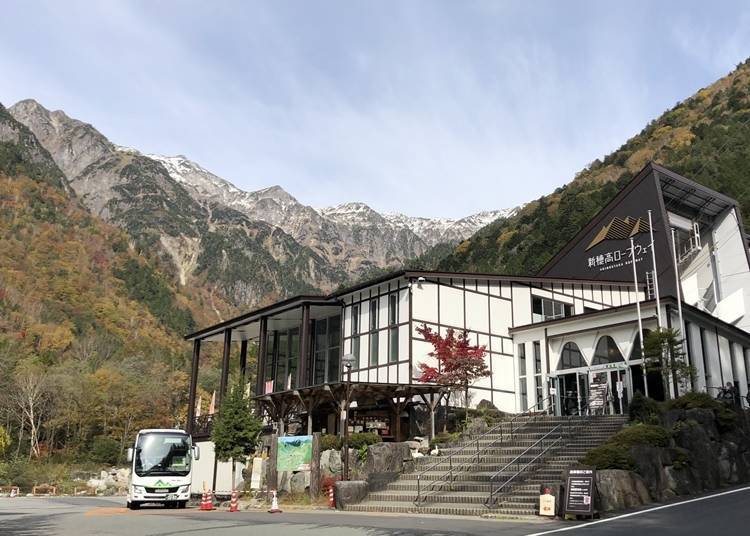
Tickets can be purchased at the ticket counters at each station. You can also buy tickets on the online ticket store Webket, 24 hours a day, 365 days a year. When you purchase a ticket, you will receive a QR code, which you can exchange for a ticket at an automatic ticketing machine station.
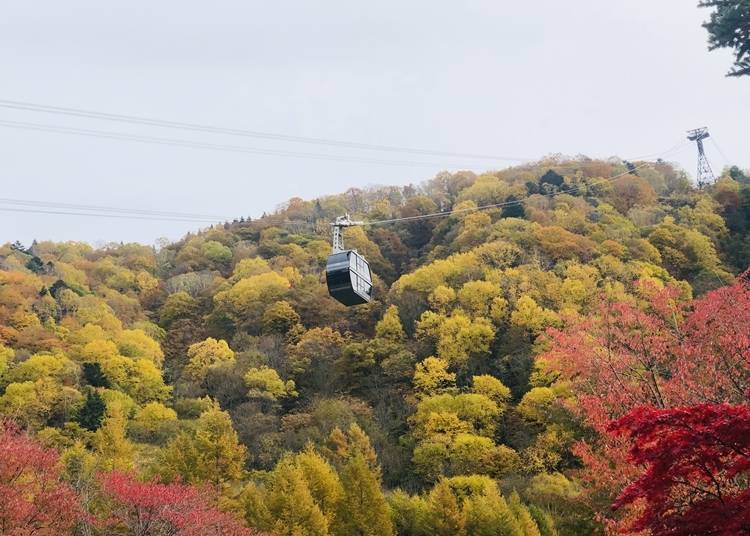
The double-decker gondola has a wider glass surface than the older model, making the view much easier to see. The ride is stable and comfortable, although it does sway a bit, passing through the pylons.
The train is equipped with four multilingual information monitors and automatic announcements in four languages (Japanese, English, Chinese, and Korean). Passengers from overseas will have an easy time using the train.
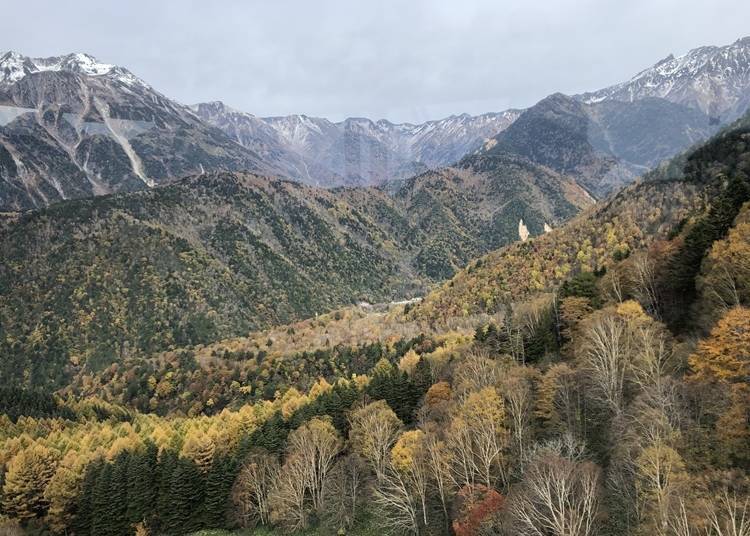
Enjoying the magnificent scenery and the comfort of the gondola ride, we arrived at Nishi-Hotakaguchi Station. The station is a five-story building with stores and a cafeteria. The main attraction is the observation deck on the roof. You can enjoy a 360-degree panoramic view of the mountains of the Northern Alps, such as Nishi Hotaka, Yarigatake, and Kasagatake.

This video shows the car window from Hirayu Onsen to Shinhotaka Ropeway. The fall leaves and the hot spring resort seen from the car window and the mountain view from the ropeway are wonderful.
-
Shinhotaka Ropeway
新穂高ロープウェイ
-
Address
Shinhotaka Onsen, Okuhida Onsen-go, Takayama, Gifu 506-1421 -
Phone Number
0578-89-2252
Hours: 8:30 AM – 4:45 PM
Admission: Ropeway no.1 and no.2: 1,700 yen one way, 3,000 yen round trip for adults; 850 yen one way, 1,500 yen round trip for children.
Closed: Always open (The bus may be closed for inspection once or twice a year) -
Address
After enjoying the spectacular view, we headed for the old town of Hida Takayama from the Shin Hotaka Ropeway. From the ropeway, take the bus bound for Takayama that departs around 12 PM. It takes about one hour and a half. Get off the bus at the “old town” stop. The fare is 2,180 yen for a 1-way trip.
7
1:30PM: Arrive and take a stroll along Sanmachi Street, a must-see for Hida Takayama visitors!
When you get off the bus, you will see the famous sightseeing spot, the Old Town, in front of you.
The old townscape is one of the most popular tourist spots in Hida Takayama, with a series of buildings existing since the Edo period. One of the most popular of these is Sanmachi-dori (Sanmachi Street), in Kamiyanomachi to Kamisanomachi, Takayama City, which is also a Preservation District for Groups of Traditional Buildings.
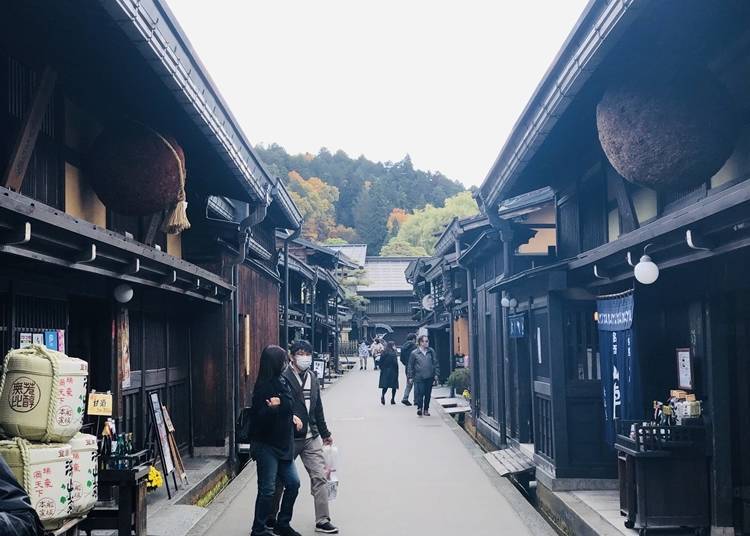
Hida Takayama is blessed with good quality rice, water, and climate, and sake brewing is flourishing. The San-machi Street is lined with many historic sake breweries, where you can enjoy local sake.
Many stores are selling traditional crafts and souvenirs, as well as restaurants and coffee shops, making this a street where people of all ages and genders can enjoy Hida Takayama. There is also a wide variety of gourmet food available for take-out, so why not take a stroll and enjoy a bite to eat?
We recommend the Hida Beef Nigiri Sushi, the hot and fluffy Beef Buns Kihachiro, and the soy-sauce-grilled Midarashi Dango.
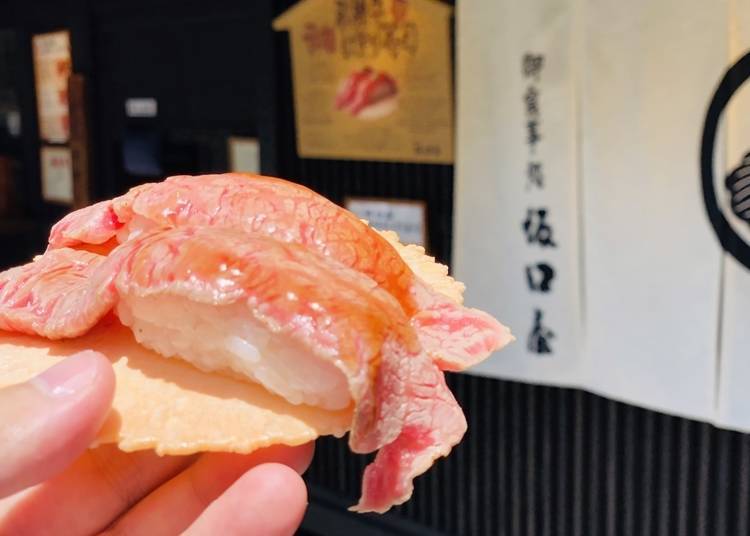
Sakaguchi-ya’s Hida beef nigiri sushi can be easily enjoyed as a take out: 700 yen (tax included). Take-out/800 yen (tax included) inside the restaurant
That time we wanted to sit down and take a break, so we went to CENTER4 HAMBURGERS, a hamburger-specialized restaurant in the old town area. We chose the Hida beef burger, a specialty sold in limited quantities. The patty is made of 100% Hida beef. One bite and your mouth will be filled with flavor.
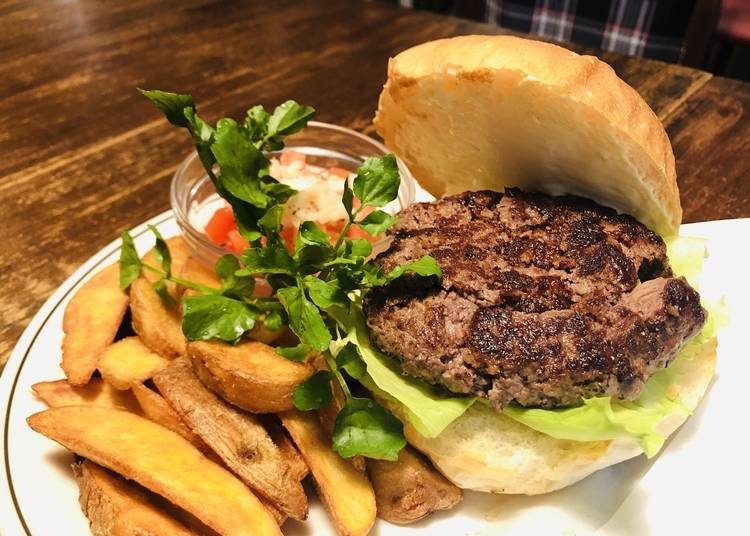
Hida beef hamburger (with fries and salad) 2,700 yen (tax included)
-
CENTER4 HAMBURGERS
CENTER4 HAMBURGERS
-
Address
94, Kamiichino-machi, Takayama, Gifu 506-0844 -
Phone Number
0577-36-4527
Open: Lunch 11 AM – 2:30 PM (last order)/dinner 5:30 PM – 8 PM (last order)
Closed: Wednesday, year-end and New Year -
Address
Historical sites and spots where you can enjoy the skills of artisans
There is also another sightseeing spot near the old streets that should not be missed. It’s Takayama Jinya, a government office where deputies and county representatives dispatched by the shogunate worked during the Edo period.
Of the 60 or so government buildings of this kind that used to exist across the country by the end of the Edo period (1860), only Takayama Jinya remains as a major building from that time, and is therefore designated as a national historic site.
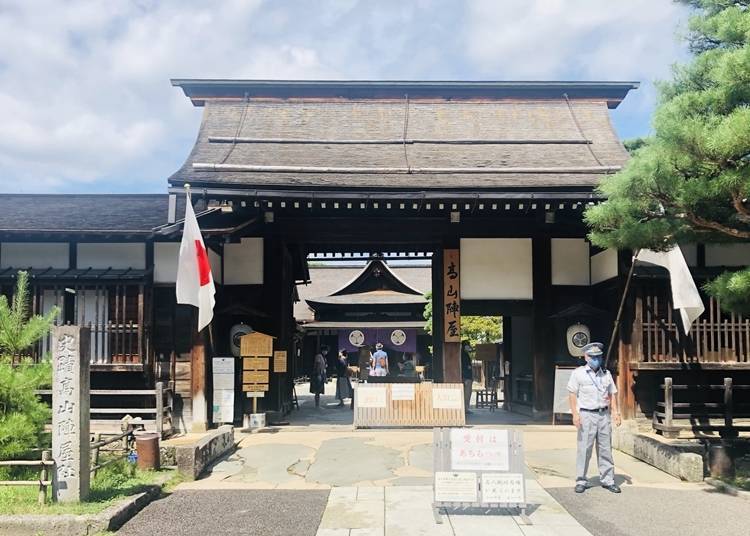
Takayama Jinya offers free guided tours of the facility by volunteers. English-speaking guides are also available, but this service has been temporarily suspended to prevent the spreading of coronavirus.
Nevertheless, the well-kempt courtyard was beautiful, and we were able to take our time to enjoy Takayama Jinya, its history, and the charm of its buildings.
-
Takayama Jinya
高山陣屋
-
Address
1-5 Hachikenmachi, Takayama, Gifu 506-0012 -
Phone Number
0577-32-0643
Open: March 1 – October 31 (Except August) 8:45 AM -5 PM/August 1 – August 31 8:45 AM – 6PM/November 1 – February 28 8:45 AM – 4:30 PM
Admission: 440 yen per person/free for high school students and younger (group discounts available)
Closed: December 29 – January 3 -
Address
There are many other places to see in the area, such as the Takayama Festival Yatai Kaikan, where gorgeous festival floats are paraded in one of the most beautiful festivals in Japan, and the Hida-no-Sato, where valuable old Hida houses, including the Gassho-Zukuri, have been moved and restored.
For those who want to enjoy more Hida beef, don’t miss Ajizo Tengoku, a restaurant specializing in Hida beef yakiniku (grilled meat), about 1 minute walking from JR Takayama Station. If you have time to spare, stay an extra night, and enjoy Hida Takayama to its fullest.
8
5PM: Check in at Takayama Green Hotel – enjoy the Japanese garden and Hida beef dinner!
After strolling through the streets, we headed for JR Takayama Station, about 10 minutes walking from Sanmachi-dori. It takes about 10 minutes on foot from Sanmachi-dori, and we boarded the free shuttle bus from JR Takayama Station to check in at the Takayama Green Hotel, where we would stay that night.
*It is also possible to walk from JR Takayama Station to Takayama Green Hotel (about a 6-minute walk).
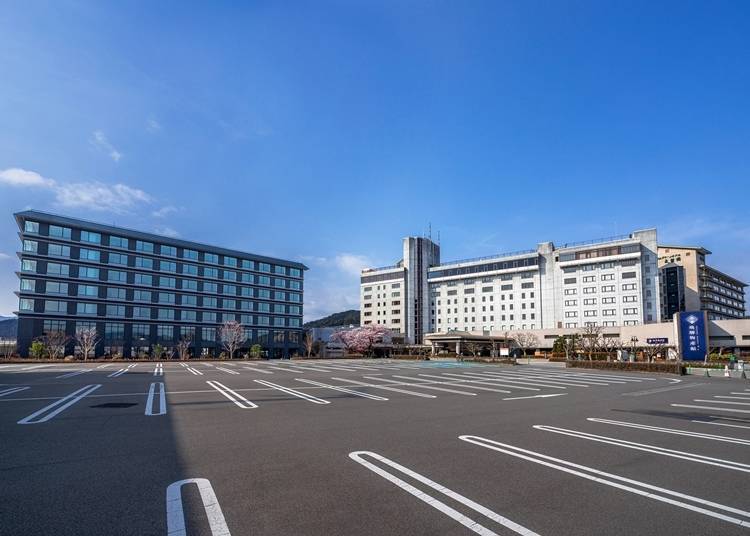
Image courtesy of Takayama Green Hotel
The Takayama Green Hotel is one of the most famous hotels in Hida Takayama. Aside from the beauty of the lobby and the rooms, you can also admire the well-kempt Japanese garden from the lounge.
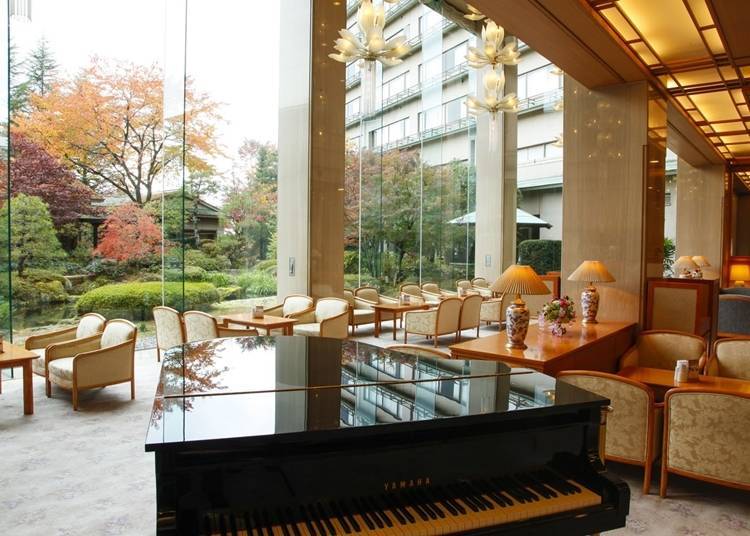
Image courtesy of Takayama Green Hotel
Takayama Green Hotel offers a wide range of guest rooms, Japanese-style and Western-style. The spacious layout, combined with the high-quality furniture made in Hida, creates a relaxing space.
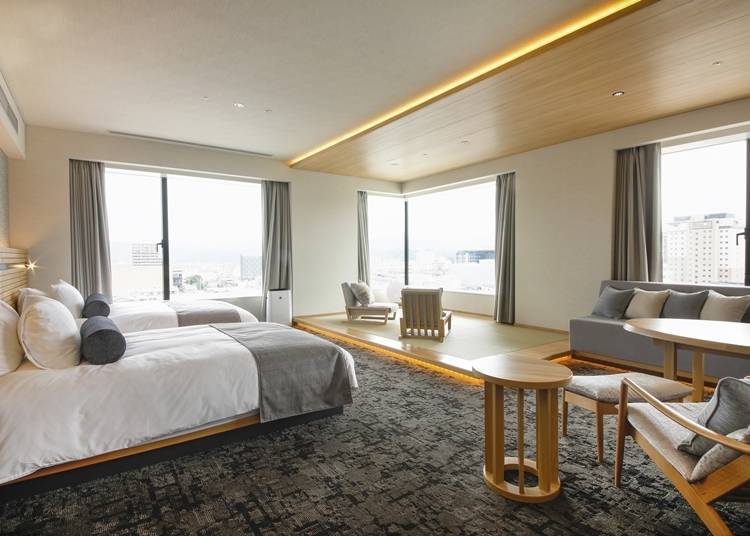
The suites are located on the east and north corners of the hotel, with wide windows that offer a panoramic view of Hida Takayama (Image courtesy of Takayama Green Hotel).
Many of the staff at Takayama Green Hotel are fluent in Chinese and English, making the stay of international visitors even more relaxing.
For meals, we recommend the Hida-beef all-you-can-eat kaiseki. You can enjoy Hida beef to its fullest with dishes like grilled beef with magnolia leaves and miso, steamed beef in a steamer basket, roast beef, and shigure-ni (beef cooked with ginger and sweet and spicy soy sauce and sugar).
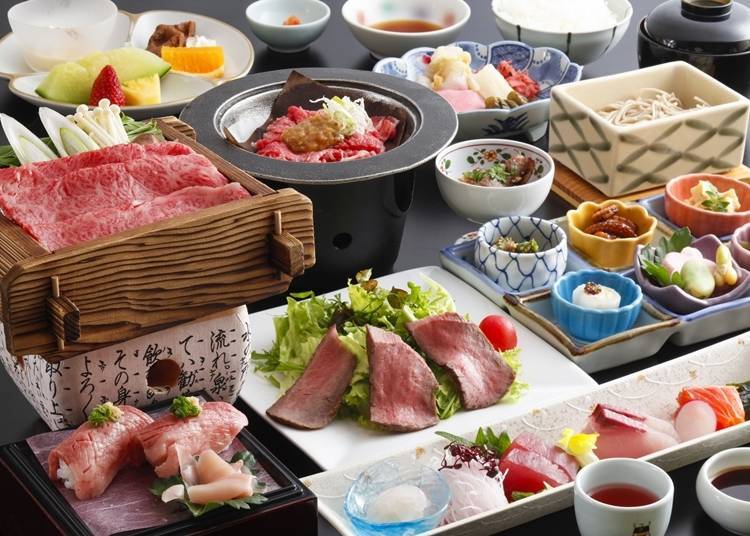
Image courtesy of Takayama Green Hotel
We were able to eat in a private room, so we could relax and enjoy ourselves in a private space. Of course, the natural hot springs are a must. We spent a luxurious time in the large Honjin Main Bath, and in the Garden Outdoor Bath, where we could enjoy the beauty of the four seasons all together.
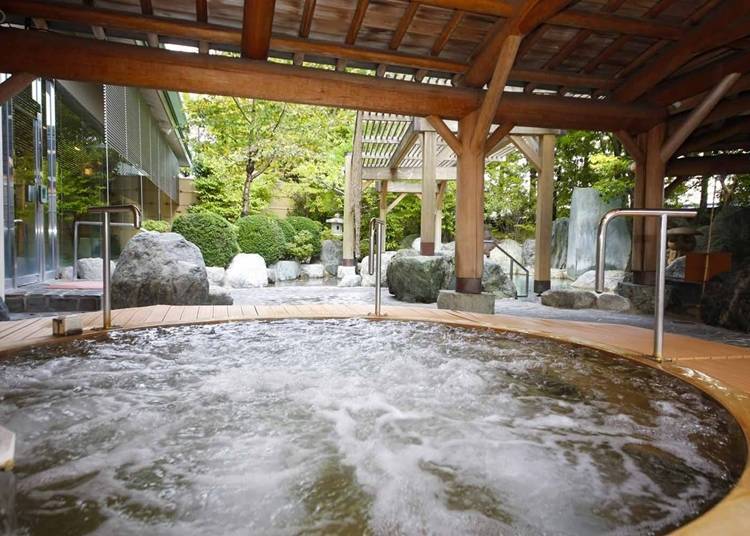
The outdoor garden bath also has a hinoki cypress Jacuzzi (Image courtesy of Takayama Green Hotel)
Furthermore, the Hida Bussan Kan, located on the grounds of Takayama Green Hotel, is like a souvenir museum with over 7,000 souvenirs! With the largest selection of products in Takayama, it’s enjoyable to just look around. In addition to shopping, there is also a corner where you can try your hand at making Hida’s folk craft sarubo and baking salt rice crackers. Try it out as part of your memories in Takayama.
The YouTube channel run by Takayama Green Hotel shows the recommended attractions to see around Hida Takayama. It’s fun to plan your trip while watching the video.
The night in Hida Takayama drew to a close with both body and soul satisfied.
-
Takayama Green Hotel
飛騨高山温泉 高山グリーンホテル
-
Address
2-180 Nishinoisshikimachi, Takayama, Gifu 506-0031 -
Phone Number
0577-33-5500
Check-in: Tenryaku-kaku 3 PM/Sakurin-kaku 2 PM
Check-out: Tenryaku-kaku and Sakurin-kaku 11 AM
Rates: from 10,450 yen per person per room (per night with two meals. Tax and service not included)Vacancy search, reservation
Check with our partner site as the latest rates, rate details, and guest room requirements may vary.
-
Address
9
Day 3: Visit Shirakawa-go to experience the original landscape of Japan
On the third day, we went to Shirakawa-go, a World Heritage site, and headed for Kanazawa City in Ishikawa Prefecture, our final destination.
First, we boarded an express bus departing from the Takayama Nohi Bus Center around 9 AM to Shirakawa-go. There are about 20 express buses that leave every day from Hida Takayama to Shirakawa-go. The fare is 2,600 yen for a one-way trip and 4,600 yen for a round-trip ticket. The ride takes about 50 minutes.
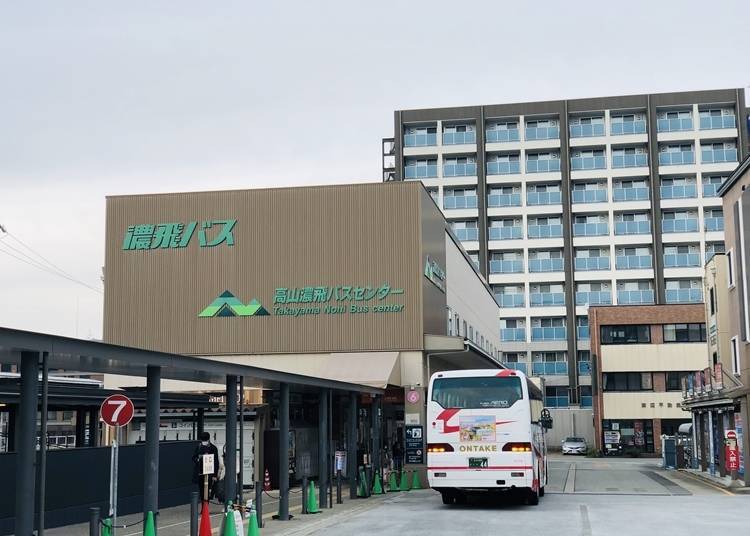
-
Takayama Nohi Bus Center
高山濃飛バスセンター
-
Address
6-125, Hanasatomachi, Takayama, Gifu 506-0026 -
Phone Number
0577-32-1688
Hours: 9:00 AM – 5:00 PM
-
Address
10
9:30AM: Arrive and enjoy the World Heritage site of Shirakawa-go!

Photo courtesy of Shirakawa Village Office, Gifu Prefecture
Shirakawa-go, a popular tourist destination in Ono-gun, Gifu Prefecture, was selected as an Important Preservation District for Groups of Traditional Buildings in 1976, and in 1995, it was registered as a UNESCO World Heritage site (cultural heritage) along with Gokayama, in Toyama Prefecture. Many tourists, both domestic and foreign, come to see the beautiful scenery, which is truly one of Japan’s most traditional landscapes.
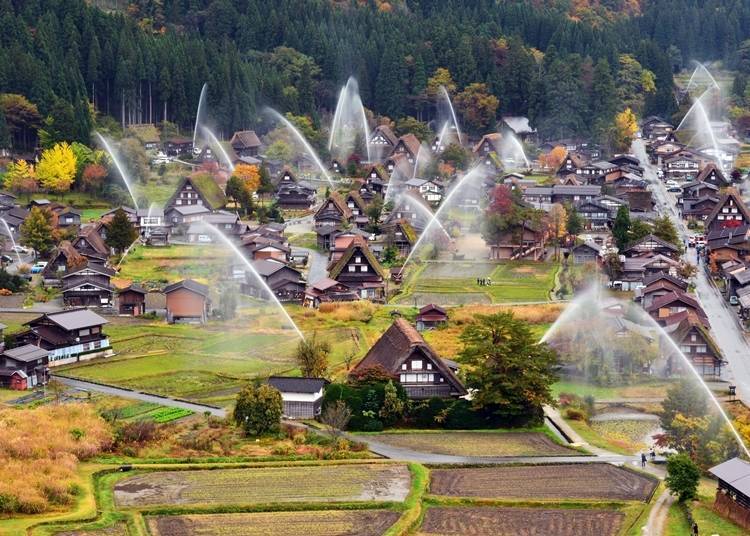
Every year, around the beginning of November, a fire drill is held to prepare for a fire.
Shirakawa-go is characterized by its Gassho-zukuri style. Gassho-zukuri refers to an architectural style in which wooden beams are assembled as if they were palms joint together. Shirakawa-go gets a lot of snow in the winter, but by using clever techniques to connect wood parts without using nails, structures are flexible enough to withstand the load.
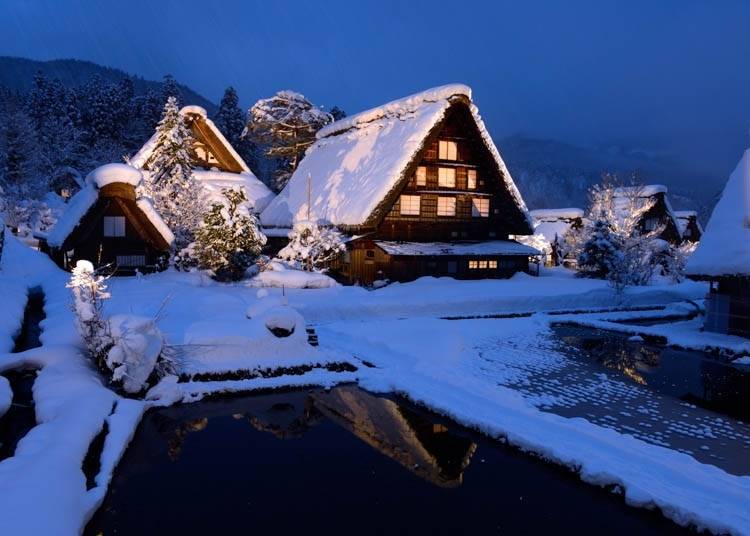
Winter illumination (Photo Courtesy of Shirakawa Village Office, Gifu Prefecture)
When it comes to the charm and scenery of Shirakawa-go, the Ogimachi Gassho-Zukuri Village, with its many houses in Gassho-Zukuri style, is symbolic. There are about 60 gassho-zukuri houses (main buildings) in this small village, which takes about one hour to walk around. There are also some coffee shops, restaurants, and souvenir shops. You can enjoy a long time just strolling around and taking pictures.

The Association for Preservation of the Natural Environment of Ogimachi Village in Shirakawa-go, established in 1971, has been promoting the preservation of Gassho-Zukuri based on the principle of “do not sell,” “do not rent,” and “do not destroy.”
As a result, many of the Gassho-Zukuri houses are still inhabited by local residents, and it is a great attraction to be able to feel the life of the houses. On the day of hour visit, I met many local residents. Don’t forget to say “hi” if you meet any.
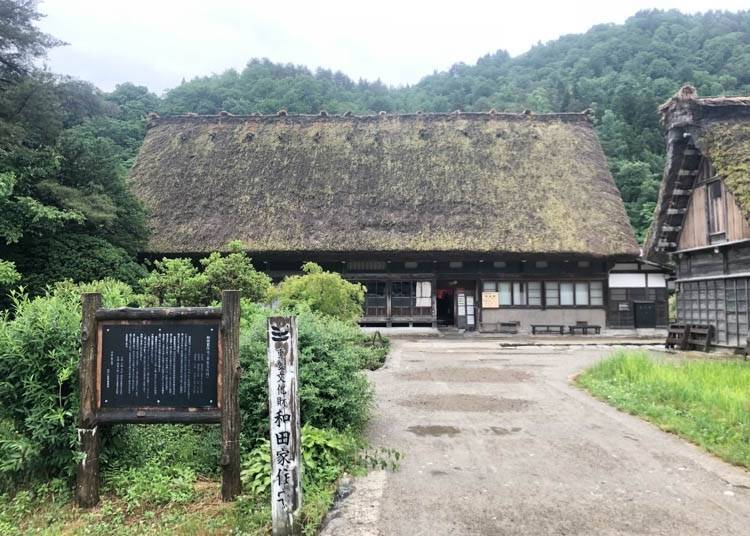
On that day, we went sightseeing at the Wada House, which is located right outside the bus terminal as is designated as an Important Cultural Property of Japan. The Wada House is one of the largest Gassho-Zukuri houses in Japan, and you can tour the interior for a fee. It was a precious opportunity to see the large hall with a sunken hearth, the beautifully decorated Buddhist room, and the attic.
-
Wada House
和田家
-
Address
997 Yamakoshi, Ogimachi, Shirakawa, Ono, Gifu 501-5627 -
Phone Number
05769-6-1058
Open: 9 AM – 5PM
Admission: 300 yen for adults, 150 yen for children -
Address
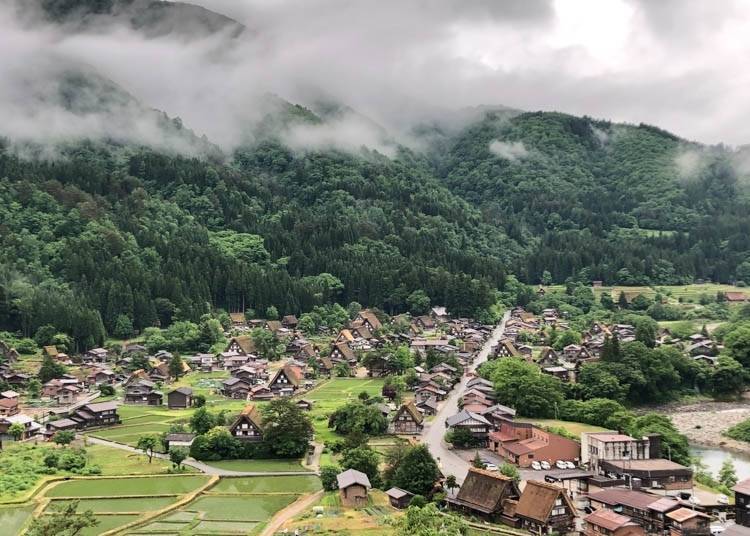
After visiting the Wada House, climb the slope on the east side for a little more than 10 minutes. At the end of the climb is the Shiroyama Observatory (Ogimachi Castle Ruins Observatory). The spectacular view of the Gassho-Zukuri village of Ogimachi is worth the hike!
-
Shirakawa-go (Shirakawa-go Tourist Association)
白川郷(白川郷観光協会)
-
Address
1086 Ogimachi, Shirakawa, Ono, Gifu 501-5627
Phone: 05769-6-1013(9 AM – 5 PM)
Free access -
Address
11
1:35 PM: Finishing in Kanazawa, home to one of Japan’s most famous gardens and rich samurai culture
After sightseeing in Shirakawa-go, there are many options for your next destination. You can head to Toyama Prefecture, home to the Tateyama Mountain Range with its 3,000-meter-high mountains, and return to Tokyo via Hida Takayama, or head south to Nagoya, Osaka, or Kyoto, all of which offer a variety of routes to famous sightseeing spots.
This is the charm of the Chubu area, located in the center of Japan.
We headed to Kanazawa City in Ishikawa Prefecture, famous for its Kenrokuen Garden, one of the three most famous gardens in Japan, and samurai residences. This is the final destination of this trip.
Take the bus from the Shirakawa-go bus terminal at around 12:20 and arrive at Kanazawa Station (East Exit) at around 1:40 PM. About 10 express buses are leaving from Shirakawa-go to Kanazawa and back, every day.
All buses from Shirakawa-go heading to Kanazawa are available only upon reservation, so please, reserve your seat before boarding at the Takayama Nohi Bus Center or Shirakawa-go Bus Terminal. The ride takes about 1 hour and 15 minutes. The fare is 2,000 yen for a one-way trip, and 3,600 yen for a round-trip ticket.

Kanazawa City, located in the center of Ishikawa Prefecture, has a long history of prosperity as the castle town of Kanazawa Castle, and the samurai culture that still permeates the city is a popular attraction.
This city also has three famous teahouse districts, including Higashi Chaya-gai, where you can catch a glimpse of Japan’s Edo period’s flower-town culture.
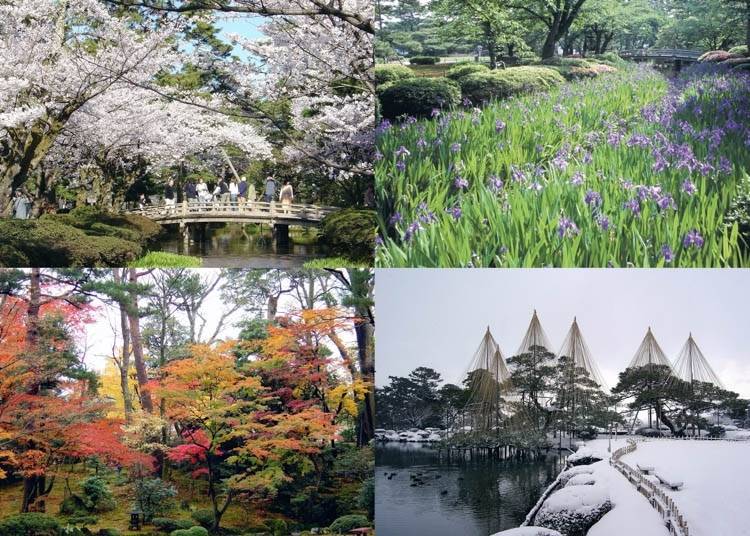
After enjoying a walk around Kanazawa, we went to Kenrokuen Garden, one of the three most famous gardens in Japan, and synonymous with Kanazawa’s sightseeing spot. Kenrokuen is a symbol among Japanese gardens, and its vast grounds are dotted with ponds, mountains, and teahouses, where you can enjoy the seasonal scenery as you stroll. I was able to take my time and appreciate the beauty of Japan.
-
Kenroku-en Garden
兼六園
-
Address
1 Kenrokumachi, Kanazawa, Ishikawa 920-0936 -
Phone Number
076-234-3800
Open: March 1 – October 15, 7 AM – 6 PM; October 16 – end of February 8 AM – 5 PM
Admission: adults (18 years and older) 320 yen; children (6-18 y/o) 100 yen
Closed: no mid-year break (except for Shigure-tei) -
Address
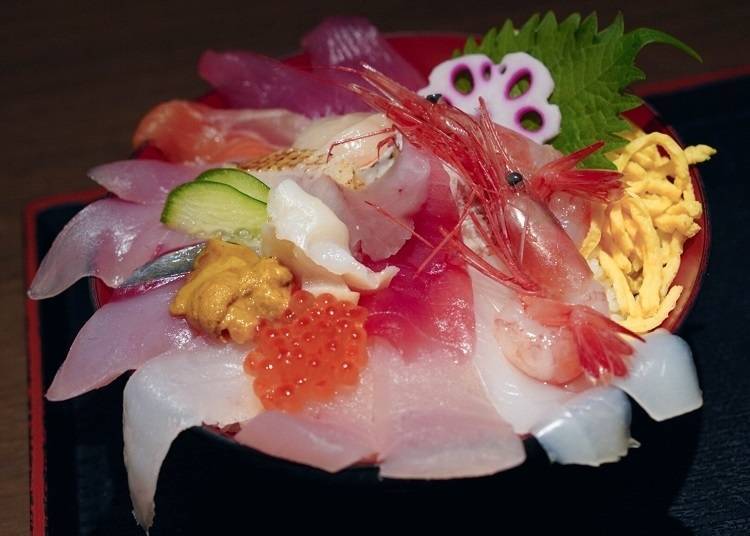
We ended our trip at the Omimachi Market, which is known as the kitchen of Kanazawa citizens. We enjoyed the lively atmosphere as we bought fresh seafood, vegetables and fruits from the Hokuriku region and ate them on the spot.
The most popular dish was the Kanazawa local kaisendon – a sushi bowl! We were served a bowl full of fresh seafood from the sea of Japan. All the kaisendon restaurants have a long queue every day, but the flavor of the dish is worth the wait in line.
-
Omicho Market
近江町市場
-
Address
50 Kamiomicho, Kanazawa, Ishikawa 920-0905 -
Phone Number
076-231-1462
Hours vary depending on store
-
Address
We finished our bus trip in the Chubu area with a happy stomach and soul. You can continue to enjoy your trip from Kanazawa or return to Hida Takayama and take the bus back to Tokyo. You can also take the Hokuriku Shinkansen to Nagano or Tokyo, instead of the bus.
What did you think? Departing from Shinjuku, we spent three days and two nights traveling through and fully enjoying the Chubu area, including the World Heritage Site of Shirakawa-go, the fall foliage of shin Hotaka, and hot springs. During the season of autumn leaves, you can enjoy the view from the bus window during the trip. If you have time, you can also stop at points of interest and interact with the locals who use the bus.
Please use this article to craft for yourself a unique bus travel experience in Japan.
This article is based on information available as of November 2020. Please note that services, prices, and hours of operation may have changed depending on circumstances. For the latest information, please visit the official website of each facility listed.
Text by: Junpei Maruyama
*This information is from the time of this article’s publication.
*Prices and options mentioned are subject to change.
*Unless stated otherwise, all prices include tax.










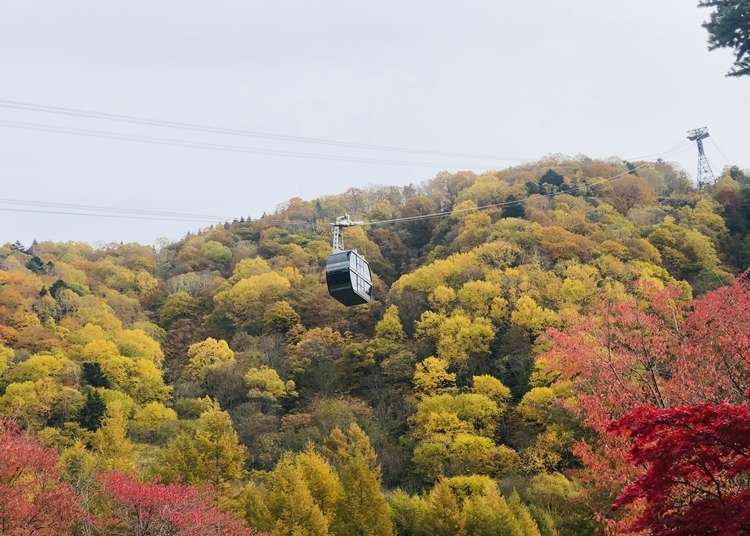



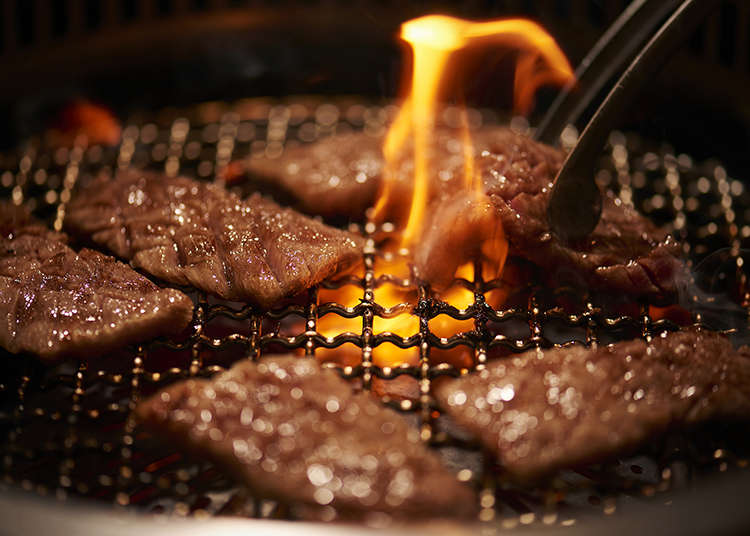


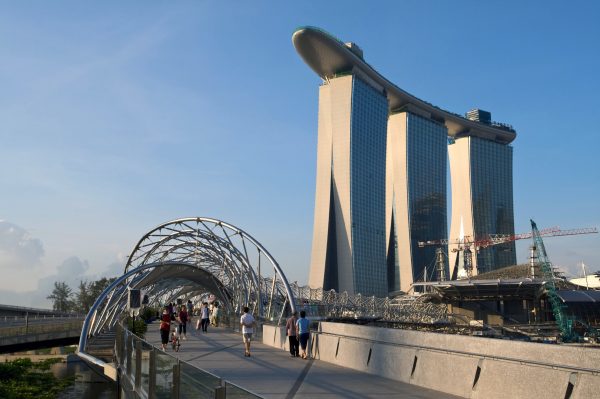




Discussion about this post